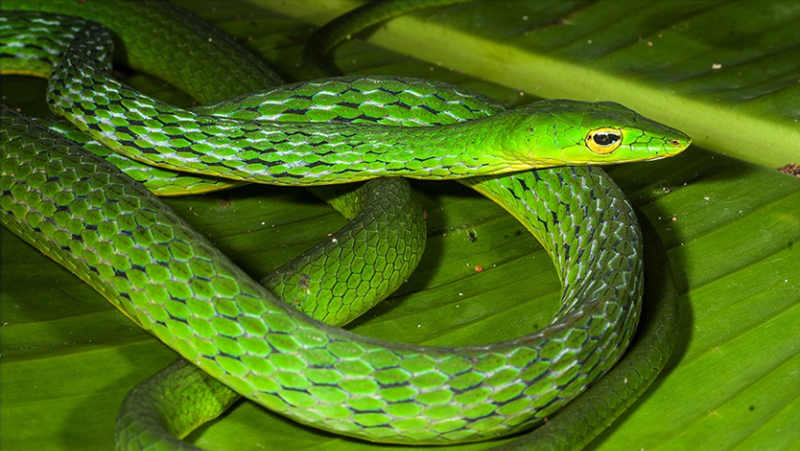
Tracing history is a tedious task. We decipher millions of clues along the way before getting to what we seek. Sometimes, nature is benevolent and throws up an entire book of history right in front—a history of not just a few centuries, but of millions of years! That's what happened when a group of herpetologists bumped into a vine snake, which they now call Proahaetulla antiqua.
"In 2011, we came across a vine snake in the Agasthyamalai hills that looked very similar to Ahaetulla dispar, a small-sized vine snake in the region with similar morphological characters. We immediately recognised it as a new species of vine snake but did not realise that it was as deeply divergent as it turned out to be," explains Dr A.K. Mallik from IISc, who is the lead author of the study.
The team of researchers, from the Indian Institute of Science, Bengaluru were attempting to study and classify snakes in the Western Ghats systematically. That's when they came across Proahaetulla antiqua, which is endemic to the southern Western Ghats. What's more interesting is that it is an ancient species, thought to have evolved around 26 million years ago during the mid-Oligocene.
“We carried out extensive field visits across India to collect morphological data, tissue samples and specimens to understand the patterns of distribution and diversification of vine snake species”, says Dr Mallik.
In a study published in the journal PLOS ONE in collaboration with researchers from Chennai Snake Park, Chennai and Bombay Natural History Society, Mumbai, the team has described the unique features of this snake. The study was funded by the Department of Biotechnology, Ministry of Environment, Forests and Climate Change, DBT-IISc Partnership Programme and the Critical Ecosystem Partnership Fund.
Vine snakes get their names because of their slender bodies and vine-like appearances. While there are similar species in Africa and South America, the Asian vine snakes, distributed throughout Asia, belong to the genus Ahaetulla. In India, there are four species of commonly distributed vine snakes, and another one was discovered in Odisha recently.
When the researchers studied the evolutionary tree of Proahaetulla antiqua, they discovered that this species had diverged from the other vine snakes about 26 million years ago. Thus, they are not only a new species but also belong to a new genus. They are named after the Latin words 'antiqua', meaning 'old or ancient'. The common name suggested for these individuals is 'keeled vine snake'.
"In addition to its high genetic divergence, the new genus, Proahaetulla, is different morphologically from closely related species. There are differences in the post-ocular scales have serrated keels on dorsal scales, a higher number of maxillary teeth, dorsal scales, ventral shields and subcaudal shields. They are also longer than others vine snakes, which are distributed sympatrically in the Western Ghats" says Dr Mallik about the appearance of the new species.
The researchers have described the new species from two individuals found in the protected habitats of the Kalakkad Mundanthurai Tiger Reserve in Tamil Nadu and the Shendurney Wildlife Sanctuary in Kerala, both located in the southern Western Ghats.
"Both individuals were found in protected areas, and this species is likely to be restricted to a small range in the southern Western Ghats", says Dr Mallik.
The discovery not only helps us know more about the evolution of vine snakes but also the evolutionary history of the Western Ghats, a landmass older than the Himalayas.
In India, the field of herpetology is evolving and we are now beginning to decipher the diversity and evolutionary history of reptiles like snakes found here. Although the Western Ghats has been one of the most explored landscapes since the colonial era, how is it that such an ancient species went unnoticed until now?
“One possible reason might be the lack of interest in taxonomic studies in general. Systematic studies need large-scale field surveys and financial support, which are lacking. Secondly, as Proahaetulla is superficially similar to Ahaetulla dispar (Gunther's vine snake), it is possible that most individuals encountered by others were misidentified as A. dispar,” shares Dr Mallik.
The discovery of an ancient species like Proahaetulla antiqua brings to light the diversity lurking in the country.
"There are many more species waiting to be discovered before going extinct due to development", says Dr Mallik.
The good news is that the new species faces no major threats at the moment.
Highly misinterpreted and misunderstood, snakes are both worshipped and threatened across India.
"Many snakes play a vital role in the ecology of the region where they are found. Snakes are important predators, and often keep prey populations such as rodents under control. Hence, there needs to be more awareness about the importance of snakes in ecosystems, and their benefits to us," signs off Dr Mallik.
